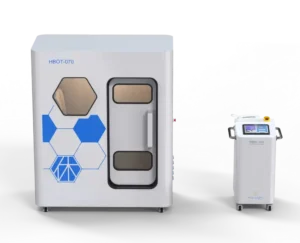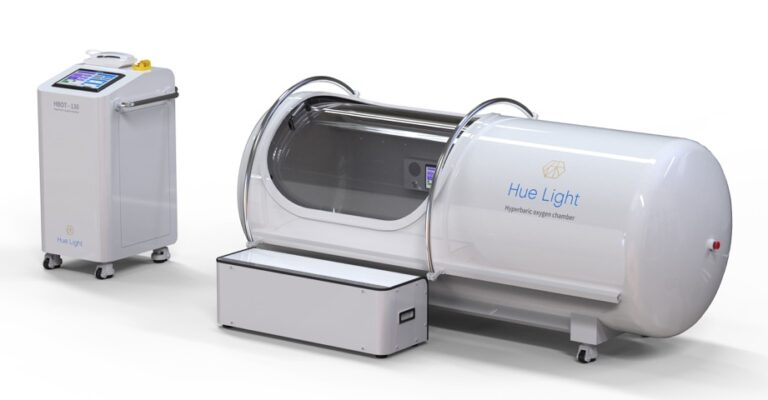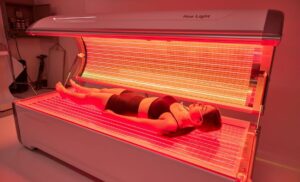Hyperbaric Oxygen Therapy (HBOT), a form of oxygen therapy and pressurized oxygen treatment, is rapidly gaining attention not only in medical clinics but also in home treatment setups around the world. From accelerating wound healing and enhancing oxygen delivery to supporting chronic conditions, this hyperbaric chamber therapy offers intriguing potential. But can home oxygen therapy be done safely and effectively using a home hyperbaric chamber?
In this blog, we’ll break down what hyperbaric oxygen therapy is, its health benefits, potential side effects, and how to use this medical device safely at home, so you can make confident, informed decisions about your wellness and overall respiratory function.
What is Hyperbaric Oxygen Therapy (HBOT)?
Hyperbaric oxygen therapy is a non-invasive medical therapy that involves breathing pure oxygen in a pressurized hyperbaric chamber where atmospheric pressure is increased to 1.5 to 3 times normal levels.
Normally, we breathe air that contains 21% oxygen. But in an HBOT chamber, the oxygen level reaches 100% due to the increased pressure. This combination of increased pressure and concentrated oxygen allows your blood to carry significantly more oxygen than usual, up to 15 times the normal amount.
This extra oxygen travels through your bloodstream and reaches areas where circulation may be reduced or damaged, supporting the body’s natural healing processes. The HBOT therapy typically lasts 60 to 90 minutes per session, during which you simply relax inside the chamber while your body absorbs the enhanced oxygen.
Traditionally, HBOT has been used in hospitals and clinics for treating conditions like carbon monoxide poisoning, diabetic wounds, and decompression sickness in divers.
But now, it’s becoming more accessible for personal, at-home use.
Related Article: Hyperbaric Chamber for Lyme Disease
Health Benefits of Hyperbaric Oxygen Therapy
Research demonstrates hyperbaric oxygen treatment’s effectiveness across multiple health conditions. The enhanced oxygen delivery triggers several beneficial biological processes that support healing and recovery.
- Wound Healing and Tissue Repair: HBOT accelerates healing for chronic wounds, diabetic ulcers, and post-surgical recovery by promoting collagen formation and new blood vessel growth. Studies show that regular HBOT sessions can reduce healing time for such wounds by up to 30-40%.
- Reduced Inflammation: The therapy helps lower inflammation, which can benefit conditions like arthritis or post-surgical swelling.
- Athletic Recovery Support: Athletes report faster recovery times and reduced muscle soreness, though scientific evidence remains limited compared to established medical applications.
- Neurological Support: The therapy supports brain function by improving oxygen delivery to neural tissues. Research indicates benefits for stroke recovery, traumatic brain injury rehabilitation, and cognitive enhancement.
- Circulation Improvement: Enhanced oxygen delivery supports cardiovascular health and improves circulation to compromised tissues.
- Immune System Support: Enhanced oxygen levels boost white blood cell function and help fight infections more effectively. The therapy also demonstrates antimicrobial properties against certain bacteria and fungi.
Related Article: 10 Science-Backed Benefits of Hyperbaric Oxygen Chamber
Can You Do Hyperbaric Oxygen Therapy at Home?
Yes, at-home HBOT is possible through specialized chambers designed for personal use. However, these systems operate differently from clinical units in several important ways.
Home HBOT chambers typically use mild hyperbaric oxygen therapy (mHBOT), operating at lower pressures (usually 1.3 to 1.5 atmospheres) compared to clinical chambers that can reach 2.5 to 3 atmospheres. They also use concentrated oxygen (typically 90-95% oxygen) rather than 100% pure oxygen used in medical settings.
This means while home units can provide increased oxygen exposure, they don’t replicate the full intensity of clinical HBOT treatments. Understanding this distinction is essential when setting realistic expectations for at-home therapy.
At Home Hyperbaric Chamber Benefits
- Convenience and Accessibility: HBOT therapy at home eliminates travel time to clinics and allows flexible scheduling around your daily routine. This convenience factor significantly improves treatment compliance for long-term protocols.
- Privacy and Comfort: Many people prefer the familiar environment of their home, reducing anxiety and promoting relaxation during sessions.
- Cost-Effectiveness Over Time: While initial investment is substantial, home units may prove more economical than repeated clinical visits for individuals requiring extended treatment protocols.
- Consistent Treatment Schedule: Home access enables more regular, consistent therapy sessions, which may enhance overall treatment effectiveness.
At Home Hyperbaric Chamber Challenges
- Limited Pressure Capabilities: Home units cannot match the therapeutic pressures available in clinical settings, potentially limiting effectiveness for certain conditions.
- Lack of Medical Supervision: Without healthcare provider oversight, users may miss important safety considerations or optimal treatment modifications.
- Maintenance Responsibility: Home units require regular cleaning, maintenance, and eventual servicing, adding ongoing responsibilities and costs.
- Space and Storage Requirements: These home chambers require dedicated space and proper storage when not in use, which may not suit all living situations.
- Initial Learning Curve: Users must become familiar with proper operation, safety protocols, and troubleshooting procedures.
Types of At-Home HBOT Systems
- Soft-Sided Chambers: These portable units use flexible materials and are generally more affordable and space-efficient. They’re easier to set up and store, but may have pressure limitations.
- Hard-Shell Chambers: Rigid chambers offer more precise pressure control and durability but require more space and a higher investment. They often provide better long-term value for regular users.
- Monoplace vs. Multiplace Chamber: Most home units are monoplace (single-person) chambers, though some larger residential units accommodate multiple people simultaneously.
- Portable Units: Some manufacturers offer compact, travel-friendly options for people requiring therapy while away from home.
Risks of HBOT at Home
While generally considered safe when used properly, at-home HBOT carries certain risks that users must understand:
- Barotrauma: Pressure changes can potentially cause ear or sinus discomfort, particularly for individuals with congestion or anatomical variations.
- Oxygen Toxicity: Though rare at home-use pressures, prolonged exposure to high oxygen concentrations can theoretically cause adverse effects.
- Fire Risk: Elevated oxygen levels increase fire hazards, making it crucial to eliminate ignition sources and follow strict safety protocols.
- Claustrophobia: Some individuals may experience anxiety or panic in enclosed chambers, particularly during initial sessions.
- Medical Contraindications: Certain conditions, including pneumothorax, severe COPD, or recent ear surgery, may contraindicate HBOT use.
- Equipment Malfunction: Mechanical failures could potentially create safety hazards if proper emergency procedures aren’t followed.
Always consult healthcare providers before beginning home HBOT, especially if you have existing medical conditions or take medications.
Choosing the Right At-Home HBOT Device
To select the best hyperbaric oxygen therapy chamber for home, it requires careful consideration on following several factors:
- Pressure Range: Look for units offering 1.3 to 1.5 ATA (atmospheres absolute), which represents the effective range for home use while maintaining safety margins.
- Chamber Size and Comfort: Consider your height, comfort preferences, and any claustrophobia concerns when evaluating chamber dimensions and design.
- Oxygen Concentration System: Evaluate whether the unit uses oxygen concentrators, compressed oxygen, or other delivery methods, each with distinct advantages and limitations.
- Safety Features: Essential safety components include pressure relief valves, emergency release mechanisms, and clear pressure monitoring systems.
- Manufacturer Support: Choose companies offering comprehensive training, ongoing technical support, and reliable service networks.
- Certification and Compliance: Verify that devices meet relevant safety standards and regulations in your region.
Practical Tips for At-Home HBOT
- Start Gradually: Begin with shorter sessions and lower pressures to allow your body to adapt and identify any adverse reactions.
- Maintain Detailed Records: Track session duration, pressure levels, and any symptoms or benefits to optimize your protocol and share with healthcare providers.
- Create a Routine: Establish consistent timing and preparation rituals to maximize therapy benefits and ensure safety compliance.
- Prepare Your Space: Ensure adequate ventilation, remove potential ignition sources, and maintain clear emergency access to your therapy area.
- Stay Educated: Keep current with best practices, safety updates, and emerging research through reputable sources and manufacturer communications.
- Regular Maintenance: Follow manufacturer guidelines for cleaning, inspection, and professional servicing to ensure optimal performance and safety.
Home-Based vs. Clinical HBOT: What’s the Difference?

Understanding the distinctions between home and clinical HBOT helps set appropriate expectations:
- Pressure Intensity: Clinical chambers achieve 2.5-3.0 ATA compared to home units’ 1.3-1.5 ATA, potentially affecting treatment efficacy for certain conditions.
- Oxygen Purity: Medical facilities use 100% pure oxygen while home units typically deliver 90-95% oxygen concentration.
- Medical Supervision: Clinical treatments include healthcare provider oversight, monitoring, and immediate emergency response capabilities.
- Treatment Protocols: Healthcare providers can adjust clinical protocols based on individual response and medical needs.
- Diagnostic Integration: Clinical HBOT often integrates with comprehensive medical evaluation and monitoring of treatment progress.
- Emergency Response: Medical facilities have immediate access to emergency interventions if complications arise.
Neither approach is inherently superior; the choice depends on individual medical needs, condition severity, and treatment goals.
Is HBOT at Home Right for You?
At-home hyperbaric oxygen therapy is becoming a powerful home treatment option for those seeking non-invasive healing, faster recovery, chronic illness management, and enhanced overall wellness. While it doesn’t replace traditional medical care, it complements it, especially for those recovering from injury, managing chronic illness, or simply striving to feel their best.
Most importantly, speak with your healthcare provider, and make sure the system you choose is safe, reputable, and suits your personal health goals.
“Looking for a Trusted Home Based HBOT Solution?”

Hue Light’s Hyperbaric Oxygen Therapy device brings hospital-grade technology into a user-friendly system you can trust.
Built with durable stainless steel and capable of reaching up to 3.0 ATA, our HBOT devices deliver oxygen therapy at a level far beyond standard home chambers. With advanced safety features, dual touchscreen controls, and integrated oxygen generation, it’s ideal for recovery, wellness, and chronic condition support.
Whether you’re healing from injury, boosting immunity, or enhancing overall wellness, Hue Light provides safe, effective therapy you can trust.
Ready to bring HBOT home? Call us at (+82) 2-898-2116 or fill out our contact form for a free consultation today.













